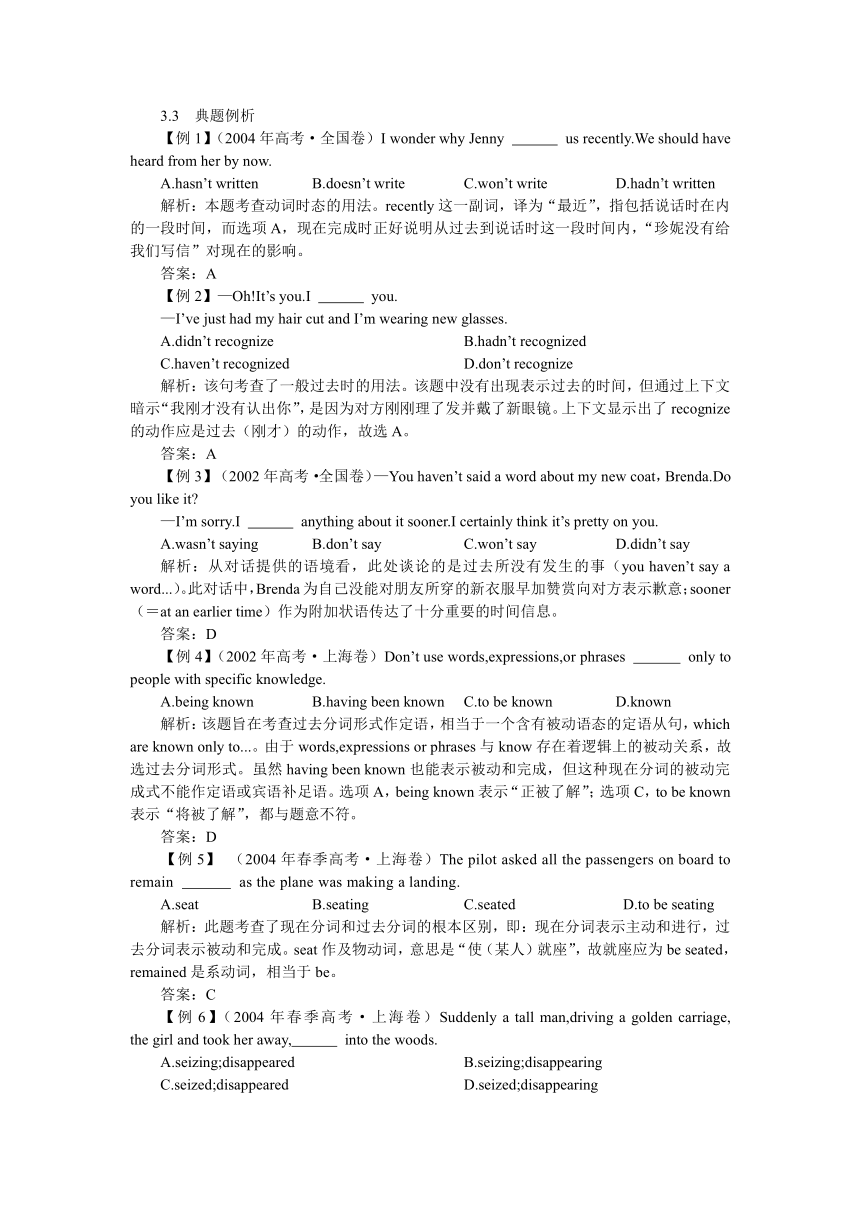新课标外研社版高中英语必修三典题例析(Module3 The Violence of Nature)
文档属性
| 名称 | 新课标外研社版高中英语必修三典题例析(Module3 The Violence of Nature) |  | |
| 格式 | zip | ||
| 文件大小 | 12.6KB | ||
| 资源类型 | 教案 | ||
| 版本资源 | 外研版 | ||
| 科目 | 英语 | ||
| 更新时间 | 2011-10-23 13:22:50 | ||
图片预览

文档简介
3.3 典题例析
【例1】(2004年高考·全国卷)I wonder why Jenny us recently.We should have heard from her by now.
A.hasn’t written B.doesn’t write C.won’t write D.hadn’t written
解析:本题考查动词时态的用法。recently这一副词,译为“最近”,指包括说话时在内的一段时间,而选项A,现在完成时正好说明从过去到说话时这一段时间内,“珍妮没有给我们写信”对现在的影响。
答案:A
【例2】—Oh!It’s you.I you.
—I’ve just had my hair cut and I’m wearing new glasses.
A.didn’t recognize B.hadn’t recognized
C.haven’t recognized D.don’t recognize
解析:该句考查了一般过去时的用法。该题中没有出现表示过去的时间,但通过上下文暗示“我刚才没有认出你”,是因为对方刚刚理了发并戴了新眼镜。上下文显示出了recognize的动作应是过去(刚才)的动作,故选A。
答案:A
【例3】 (2002年高考·全国卷)—You haven’t said a word about my new coat,Brenda.Do you like it
—I’m sorry.I anything about it sooner.I certainly think it’s pretty on you.
A.wasn’t saying B.don’t say C.won’t say D.didn’t say
解析:从对话提供的语境看,此处谈论的是过去所没有发生的事(you haven’t say a word...)。此对话中,Brenda为自己没能对朋友所穿的新衣服早加赞赏向对方表示歉意;sooner(=at an earlier time)作为附加状语传达了十分重要的时间信息。
答案:D
【例4】(2002年高考·上海卷)Don’t use words,expressions,or phrases only to people with specific knowledge.
A.being known B.having been known C.to be known D.known
解析:该题旨在考查过去分词形式作定语,相当于一个含有被动语态的定语从句,which are known only to...。由于words,expressions or phrases与know存在着逻辑上的被动关系,故选过去分词形式。虽然having been known也能表示被动和完成,但这种现在分词的被动完成式不能作定语或宾语补足语。选项A,being known表示“正被了解”;选项C,to be known表示“将被了解”,都与题意不符。
答案:D
【例5】 (2004年春季高考·上海卷)The pilot asked all the passengers on board to remain as the plane was making a landing.
A.seat B.seating C.seated D.to be seating
解析:此题考查了现在分词和过去分词的根本区别,即:现在分词表示主动和进行,过去分词表示被动和完成。seat作及物动词,意思是“使(某人)就座”,故就座应为be seated,remained是系动词,相当于be。
答案:C
【例6】(2004年春季高考·上海卷)Suddenly a tall man,driving a golden carriage, the girl and took her away, into the woods.
A.seizing;disappeared B.seizing;disappearing
C.seized;disappeared D.seized;disappearing
解析:句中的seized和下文中的took由and连接为并列谓语,而disappearing in the woods是v.-ing形式作结果状语,句子的主语和disappear(不及物动词)只能存在着逻辑上的主动关系,故用v.-ing形式。
答案:D
【例7】We are living in an age many things are done on computer.
A.which B.that C.whose D.when
解析:此题考查定语从句的关系词。定语从句选用关系词要从两个方面判断:一是先行词是什么,二是关系词在从句中作什么成分。此题涉及到定语从句关系词的正确使用问题,先行词age表示时间,而且关系词在定语从句中作状语,故选用when。
答案:D
【例8】(2002春季高考·上海卷)The famous scientist grew up he was born and in 1930 he came to Shanghai.
A.when B.whenever C.where D.wherever
解析:本题考查where引导的地点状语从句。体会语境便知:那位著名科学家是在他的出生地长大的,于1930年来到上海。此处...where he was born...相当于...in the place where he was born...。又如:We must camp where we can get water.我们必须在能找到水的地方扎营。
答案:C
【例9】(2000年春季高考·京、蒙、皖卷)The picture on the wall is painted by my nephew.
A.having hung B.hanging C.hangs D.being hung
解析:该题主要考查v.-ing形式作定语。A项是完成式,不能用作后置定语。C项是谓语动词,亦应排除。D项是v.-ing形式的被动式,强调动作。而此处强调的是“画挂在墙上”这样一种状态。
答案:B
【例10】(2002年高考·上海卷)In order to gain a bigger share in the international market,many state-run companies are striving their products more competitive.
A.to make B.making C.to have made D.having made
解析:这句话的意思是“为了在国际市场上取得更大的份额,许多国有公司正努力使自己的产品具有竞争性”。在四个选项中,只有动词不定式可作目的状语。
答案:A
【例1】(2004年高考·全国卷)I wonder why Jenny us recently.We should have heard from her by now.
A.hasn’t written B.doesn’t write C.won’t write D.hadn’t written
解析:本题考查动词时态的用法。recently这一副词,译为“最近”,指包括说话时在内的一段时间,而选项A,现在完成时正好说明从过去到说话时这一段时间内,“珍妮没有给我们写信”对现在的影响。
答案:A
【例2】—Oh!It’s you.I you.
—I’ve just had my hair cut and I’m wearing new glasses.
A.didn’t recognize B.hadn’t recognized
C.haven’t recognized D.don’t recognize
解析:该句考查了一般过去时的用法。该题中没有出现表示过去的时间,但通过上下文暗示“我刚才没有认出你”,是因为对方刚刚理了发并戴了新眼镜。上下文显示出了recognize的动作应是过去(刚才)的动作,故选A。
答案:A
【例3】 (2002年高考·全国卷)—You haven’t said a word about my new coat,Brenda.Do you like it
—I’m sorry.I anything about it sooner.I certainly think it’s pretty on you.
A.wasn’t saying B.don’t say C.won’t say D.didn’t say
解析:从对话提供的语境看,此处谈论的是过去所没有发生的事(you haven’t say a word...)。此对话中,Brenda为自己没能对朋友所穿的新衣服早加赞赏向对方表示歉意;sooner(=at an earlier time)作为附加状语传达了十分重要的时间信息。
答案:D
【例4】(2002年高考·上海卷)Don’t use words,expressions,or phrases only to people with specific knowledge.
A.being known B.having been known C.to be known D.known
解析:该题旨在考查过去分词形式作定语,相当于一个含有被动语态的定语从句,which are known only to...。由于words,expressions or phrases与know存在着逻辑上的被动关系,故选过去分词形式。虽然having been known也能表示被动和完成,但这种现在分词的被动完成式不能作定语或宾语补足语。选项A,being known表示“正被了解”;选项C,to be known表示“将被了解”,都与题意不符。
答案:D
【例5】 (2004年春季高考·上海卷)The pilot asked all the passengers on board to remain as the plane was making a landing.
A.seat B.seating C.seated D.to be seating
解析:此题考查了现在分词和过去分词的根本区别,即:现在分词表示主动和进行,过去分词表示被动和完成。seat作及物动词,意思是“使(某人)就座”,故就座应为be seated,remained是系动词,相当于be。
答案:C
【例6】(2004年春季高考·上海卷)Suddenly a tall man,driving a golden carriage, the girl and took her away, into the woods.
A.seizing;disappeared B.seizing;disappearing
C.seized;disappeared D.seized;disappearing
解析:句中的seized和下文中的took由and连接为并列谓语,而disappearing in the woods是v.-ing形式作结果状语,句子的主语和disappear(不及物动词)只能存在着逻辑上的主动关系,故用v.-ing形式。
答案:D
【例7】We are living in an age many things are done on computer.
A.which B.that C.whose D.when
解析:此题考查定语从句的关系词。定语从句选用关系词要从两个方面判断:一是先行词是什么,二是关系词在从句中作什么成分。此题涉及到定语从句关系词的正确使用问题,先行词age表示时间,而且关系词在定语从句中作状语,故选用when。
答案:D
【例8】(2002春季高考·上海卷)The famous scientist grew up he was born and in 1930 he came to Shanghai.
A.when B.whenever C.where D.wherever
解析:本题考查where引导的地点状语从句。体会语境便知:那位著名科学家是在他的出生地长大的,于1930年来到上海。此处...where he was born...相当于...in the place where he was born...。又如:We must camp where we can get water.我们必须在能找到水的地方扎营。
答案:C
【例9】(2000年春季高考·京、蒙、皖卷)The picture on the wall is painted by my nephew.
A.having hung B.hanging C.hangs D.being hung
解析:该题主要考查v.-ing形式作定语。A项是完成式,不能用作后置定语。C项是谓语动词,亦应排除。D项是v.-ing形式的被动式,强调动作。而此处强调的是“画挂在墙上”这样一种状态。
答案:B
【例10】(2002年高考·上海卷)In order to gain a bigger share in the international market,many state-run companies are striving their products more competitive.
A.to make B.making C.to have made D.having made
解析:这句话的意思是“为了在国际市场上取得更大的份额,许多国有公司正努力使自己的产品具有竞争性”。在四个选项中,只有动词不定式可作目的状语。
答案:A
